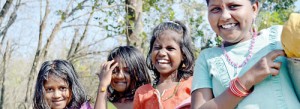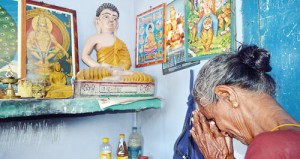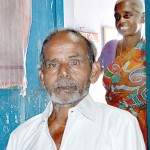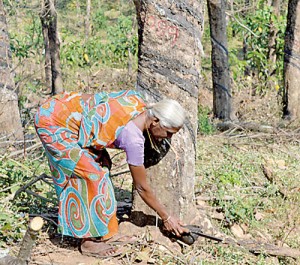News
Ceylonkarans, our lost tribe in Kerala
Tears well up and roll down her cheeks despite a struggle to maintain her composure. A sob escapes as she wipes the tears away with the ragged

All smiles: Third generation Ceylonkarans
cloth she is wearing. “Mata Lankawa mathak wenawa. Ehe inna mage gedara aya mathak wenawa (I miss Sri Lanka every day. I miss my family there),” Jayawickrama Gamage Nayanawathi, 70, finally blurts out.
Six hundred thousand Tamils including Tamils of Indian origin (who settled in Sri Lanka under the Sirima-Shasthri Pact in the 50s) fled the country following the 1983 riots. They were settled in rehabilitation centres mainly in Tamil Nadu. Some have found refuge in other states such as Karnataka and Kerala
Thousands of Tamils of Indian origin who fled Sri Lanka have been settled in Rehabilitation Plantations – mainly near rubber-bearing – in Kerala. Nayanawathi, married to a Tamil, is the only living Buddhist in the Rehabilitation Plantation in Kulattupuzha, Kerala.
Kulattupuzha is 63.5 km away from Kollam, a tourist destination in Kerala. It is famous for Ashtamudi Lake, a beautiful backwater, the most visited lake in Kerala. It is a two-hour bus journey over scenic lakes, through tapioca (manioc) and rubber estates before reaching Koovakada Junction where the Rehabilitation Plantation is situated.

Daily ritual: Nayanawathi lights an oil lamp and recites Dhamma Pada in front of the one foot Buddha statue she took with her from Sri Lanka
Seven hundred families from Sri Lanka were settled here and as a result the junction next to the plantation gained the name “Ceylon Junction” among the locals. Nyanawathi lives in one of the 13 colonies in the centre, which covers more than 1,300 hectares.
She is in her living room, a six-by-11-foot chamber filled with a bed, books, glassware and ornaments on a table and an old cupboard. When we arrived, the couple brought four chairs in from the only other room in the house for us.
“I came to India with my husband and two sons,” she said, in Sinhala, which they speak

Domanathan in his house
mostly at home. Her husband, 72-year-old Marimuttu Domanathan, is an ethnic Tamil whose grandfather went from India to Sri Lanka to work on estates during British rule, like the grandparents and great-grandparents of most of those in the centre.
The refugees were paid (Indian) Rs. 13 per day initially at the Rehabilitation Plantation. But Rs. 30 then, Nayanawathi said, was more than enough to survive on for a week. Today, an estate worker earns Indian Rs. 308 a day.
Nayanawathi lived in Opanayaka, on the outskirts of Ratnapura, and Domanathan was her neighbour. After meetings, greetings and occasional smiles, a love affair sparked between the two. Later, they married. The hardest decision they made during their marriage, she recalled, was to leave Sri Lanka and settle in a country quite alien to both of them.

Kanni Amma: Longs for the quiet lanes in Dehiowita, Kegalle
Even after 31 years the mother of two failed to adjust to the lifestyle of people in Kerala and the idea that she is 1,900km away from home. She also misses the Sinhala and Tamil New Year, which she celebrated with her sisters and brothers.
When these refugees settled in Kerala they tried to follow the same traditions and cultures as they did in Sri Lanka. But these festivities were short-lived because the locals opposed a community that followed alien rituals.
Nayanawathi is close to her birth country in many ways. Among the few treasures that she managed to bring when they travelled to India was a one-foot Buddha statue. This statue, placed gently between folded clothes, was brought in the boat they took when they crossed the sea to their new land.
Today her little treasure sits next to another one Domanathan hired a potter from Kerala to make. Every morning, Nyanawathi offers flowers, lights an oil lamp and recites Dhamma Pada in front of the two Buddha statues.
Looking over the rubber trees and the setting sun from her house, Nayanawathi makes a wish. “I want to see my country one last time before I die,” she sighed.
She is not the only one who longs to see the country in which they were born and grew up.
Huddled in a corner of the boat with her sister and two brothers Kanni Amma, then aged 24, did not know what to expect at the end of their journey. All she knew was that her parents had decided to go to another land because the situation was not good for them in Sri Lanka. She remembers pressing a bundle of clothes, the only things she brought from home, to her chest. Little did she know that they were never to go back.
Kanni Amma is now 59 years old but still her heart and dreams are in the quiet lanes in Dehiowita, Kegalle, where she grew up. “Other countries cannot match our country even though it is small. I’d still like to go there and live. If they asked me to come today, I would go,” she said, smiling.
| Lost between two nationsThese re-settlers are lost between two nations. In Sri Lanka they are long forgotten and in India they are still identified among the locals as outsiders. They are called Ceylonkarans or “Sri Lankan people,” a term which isolates them from others. Here at the plantation, the Ceylonkarans are given free accommodation, water and electricity. There is a Tamil medium school and a 16-bed hospital. They also have voting rights, because they are Tamils of Indian origin The manager of the Rehabilitation Plantation, R. Jayaprakash, who has been working there since 2000, said that even though the management has ensured to provide them with basic facilities the Ceylokarans are still not ready to interact with other communities. “They are now Indian nationals. But those from the first generation rarely go out of the plantation and associate with the Malayalees,” he said. “They also marry within their community. Very rarely do we hear that a Sri Lankan re-settler married someone from another state or even, outside the plantation.” As a result, he said, the Tamil population inside the plantation was increasing which had the effect of isolating those people even more. The plantation’s Welfare Officer, K.J. Bose, who has been working there for the past 19 years, said that they are hopeful that the third generation, now aged one to 25 years, would change their fate. This generation speaks and studies in Malayalam, the national language in Kerala. Another problem the Ceylonkarans face in India that unlike other communities in special need, they lack a Scheduled Caste (SC) or Scheduled Tribe (ST) certificate. When they came to India, the only identification they had was a passport and a family card with the names of the family members who emigrated. In India, a person who has an SC or ST are given special benefits from the government. It also helps them to enter universities and even get jobs. But since the Ceylonkarans do not have them, those who wish to work in places other than the plantation struggle to find secure employment or to enrol in higher education institutions. Closely-watched election gives hope New hope was triggered in the hearts of Ceylonkarans when Maithripala Sirisena was named the new president. One of the most excited people in the Rehabilitation Plantation in Kulattupuzha, Kerala was Marimuttu Domanathan, 72. Domanathan keeps up an active interest in politics and is a member of the Panjayatha Party in Kerala. He said he closely followed all the news about the Sri Lankan election in newspapers and thinks that it will be a change for the country to have a new leader. “Now the Tamil and Sinhala people in the country can work together to develop the country,” he said explaining that the former president could have won the elections if he did not involve his family in politics. “That is not the way to govern a country. We hope that the new president will not follow his footsteps.” Perisamy Selvaraj, 60, who was living in Pamankada before he came to India, also said that they are hopeful that the new President would look into the problems faced by the estate workers in Sri Lanka. “Apita yanna hithenawa lankawata eth thama hithe baya thiyenawa (We feel like going back to Sri Lanka but we are still scared),” he said. |

